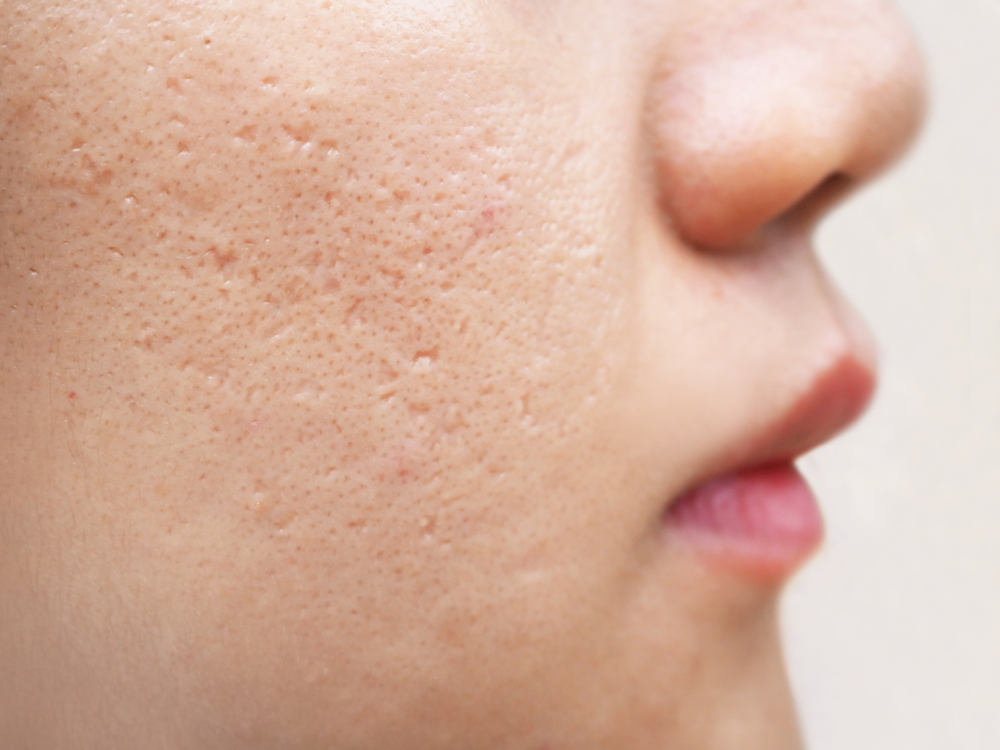How To Remove Chicken Pox Scars in Adults and Children
Chicken pox, caused by the varicella-zoster virus, is highly contagious and lasts 5-10 days, marked by fever, headaches, and an itchy rash. While usually not fatal, it’s a common childhood illness that can result in lasting scars on the body and face, causing distress and discomfort for those affected.
Frequent scratching of chicken pox blisters can lead to skin damage, prompting the body to produce thicker scar tissue to repair it. This scar tissue can result in sunken scars, particularly common with the inflammation associated with chicken pox.
Vaccination has significantly reduced the occurrence of chicken pox, yet chicken pox scars remain prevalent among children. Additionally, adults who haven’t contracted chicken pox and lack immunity through vaccination can also be affected by this common skin condition.
People often want to reduce or remove chicken pox scars, especially if they’re on the face.
Different Varieties of Chicken Pox Scarring
• Raised scars
These scars develop at the site of skin injury and can sometimes grow larger than the original wound.
• Atrophic scars
Atrophic scars are characterised by a pitted and sunken appearance. They occur when the collagen in your skin is damaged, preventing proper healing of the scar.
• Round marks
Round marks are typically minor scars characterised by their red or brown texture. They are often easily treated.
Healing Timeline for Chicken Pox Scars
Chicken pox scar healing is based on factors like infection severity and skin healing ability. Here’s a general timeline:
• Initial Lesion (Days 1-7)
Red patches develop into fluid-filled blisters, which may last for days with new ones emerging.
• Crusting (Days 7-14)
Blisters dry, forming scabs. Avoid picking to prevent scarring.
• Phase of Healing (Weeks 2-3)
Scabs gradually fall off, revealing healing skin that may appear red or discoloured.
• Formation of Scars (Weeks to Months)
Scars may initially appear red and raised but may improve over time.
• Fading (Months to Years)
Scars flatten and fade gradually, with some continuing to improve over months or years.
Factors Influencing The Recovery Of Scar Recovery
It’s worth mentioning that although most chicken pox scars fade significantly with time, some may endure or need additional scar removal treatment.
The timeline of chicken pox scar recovery can be influenced by the below-mentioned factors:
• Age of the person
• Skin Type
• The severity of the infection
• Existing conditions affecting skin recovery
• Proper care for wounds during the initial phase
How To Remove Deep Chicken Pox Scars Naturally – Home Remedies
• Aloe Vera Gel
Known for its scar-reducing properties, aloe vera gel not only moisturises the skin but also helps diminish the appearance of scars.
Regular application of aloe vera gel on the affected areas can gradually fade the marks. For an added boost, consider using aloe vera gel in a face mask to expedite the natural fading process of scars.
• Vitamin E
With its anti-inflammatory properties, Vitamin E is effective in naturally minimizing the visibility of scars. It accelerates the healing process by eliminating dead skin cells from the skin’s surface, aiding in the reduction of scar appearance.
• Coconut Water
A natural remedy for scar removal, coconut water contains lauric acid, a superb moisturiser. This acid aids in diminishing scar redness and prevents skin dryness. Additionally, coconut water’s antibacterial properties guard against infections in scars.
• Lemon Juice
Abundant in vitamin C, lemon juice aids skin healing by boosting collagen production and accelerating the recovery process. Its antioxidants combat free radicals in the body, diminishing the visibility of scars and discoloration.
• Rosehip Oil
A natural solution for scars, rosehip oil is rich in vitamin C, aiding in accelerated healing and inflammation reduction. Rosehip seed oil is especially effective in reducing the appearance of existing scars, making them less noticeable.
Effective Over-The-Counter Scar Treatments To Remove Chicken Pox Scars
Some of the most common treatments to remove chicken pox marks:
• Scar removal creams
Scar removal creams contain different ingredients aimed at reducing scar pigmentation. These creams come in different brands.
Over-the-counter creams with alpha hydroxy acids (AHAs) like glycolic, lactic, or mandelic acids are commonly used for chicken pox scars. They exfoliate the skin, promote new cell growth, and help soften and fade scars.
• Retinol Creams
Retinol creams, enriched with vitamin A, are commonly utilised to reduce by enhancing collagen production in the skin.
Research indicates that retinol, along with glycolic acid, is effective in reducing acne scars. Apply a retinol cream nightly on scars; if irritation occurs, try using it every other day instead.
• Silicone Sheets
Silicone sheets are the top OTC treatment to remove chicken pox marks. These thin, flexible sheets infused with silicone gel, vitamin E, and aloe vera gently flatten and smooth scars over a few months, accelerating the fading process.
• Exfoliants
Exfoliants aid in eliminating chicken pox scars by sloughing off damaged skin cells, promoting the growth of fresh skin. Mechanical exfoliants like scrubs and skin brushes can be applied directly to scars daily.
Additionally, chemical exfoliants available over the counter create a mild chemical reaction with the scar, facilitating skin renewal.
How To Cure Chicken Pox Scars – Specialised Professional Treatments
• Microneedling
Microneedling stands out as a safe option to remove chicken pox scars. This procedure boosts skin regeneration by creating micro-injuries with fine needles, stimulating the healing process.
• Skin grafting
Skin grafting is a scar removal procedure where the skin is transplanted from one part of your body to cover scars.
• Laser process
Laser resurfacing, a trusted method by dermatologists, effectively treats chicken pox scars in top clinics. This procedure uses intense light pulses to eliminate damaged skin and boost collagen production, reducing scar appearance over time.
Dermatologists carefully regulate laser intensity to prevent harm to surrounding healthy skin, minimizing side effects like temporary swelling or redness post-treatment.
• Microdermabrasion
Microdermabrasion is a gentle procedure for resurfacing the epidermis, involving the use of abrasive crystals propelled onto the skin by a handheld vacuum system. This mechanical abrasion removes the outer layer of the skin, prompting the formation of a new epidermis with an improved appearance.
• Chemical peeling
Chemical peeling effectively reduces scar appearance by applying a chemical solution to the skin, causing the outer layer to peel off and reveal new skin. This process, which can be repeated for desired results, commonly utilises glycolic acid and salicylic acid peels.
• Grafting
Grafting, a surgical process, is a method to conceal scars by using healthy skin. It involves removing a small piece of skin from another body area (donor site) and placing it over the scarred area.
• Dermal fillers
Dermal fillers fill in pockmarks using natural or synthetic substances to even out the skin’s surface.
• Combination treatments
Your doctor may suggest using one or a combination of the aforementioned treatments based on your medical history.
Understanding the Cost Element of Chicken Pox Scar Removal Treatment
Chicken pox scar removal costs in India are based on location, clinic choice, treatment type, procedure duration, and doctor’s experience.
Prices range from Rs 40,000 to Rs 1 lakh per patient, depending on treatment needs.
Preventing Chicken Pox Scarring: Effective Measures
• Try your best to resist scratching and aim to maintain short fingernails to minimise the urge.
• If you scratch your blisters, wash your hands with soap for 20 seconds.
• Cleanse your face twice daily, using a gentle, fragrance-free cleanser to remove impurities and excess oil without irritating your skin. After washing, pat your skin dry gently with a soft towel, avoiding rubbing.
• Taking a cool bath with baking soda added to the water can relieve itching.
• Gently apply a calming lotion containing either calamine or aloe vera by dabbing or patting it onto the blisters.
• Refrain from using anti-itch medication without consulting a physician.
• Protect healing skin from direct sunlight, as UV rays can worsen scarring. When outdoors, use a broad-spectrum sunscreen with SPF 30 or greater.
• Consider quitting or reducing smoking, as it can slow down skin healing and make scars more noticeable.
• In addition to advice from dermatologists, both adults and children can benefit from adopting healthy skincare practices to promote the fast healing of chicken pox scars and minimise any lasting marks.
Before trying any product or treatment for chicken pox scars, consider consulting a dermatologist at Labelle. With their expertise and experience in scar management, they can recommend the most suitable option based on your skin condition.
Transform Your Skin: Labelle Clinic’s Expert Care for Chicken Pox Scar Removal
Labelle stands out as the preferred skin clinic for chicken pox scar removal treatment for both adults and children. The clinic boasts a team of highly skilled dermatologists and medical professionals who specialise in scar management, ensuring personalised and effective treatment plans tailored to each patient’s unique needs.
Labelle’s dermatologists prioritise comprehensive pre and post-procedure care, utilizing state-of-the-art technology and adhering to stringent safety protocols.
With the expertise, cutting-edge technology, and compassionate approach, Labelle Clinic is your trusted partner in achieving smooth, scar-free skin and renewed confidence.
Book your appointment soon to remove chicken pox scars!
FAQs : How to Remove Chicken Pox Scars
Are chicken pox and measles caused by the same virus?
The varicella-zoster virus causes chicken pox, while the measles virus, also known as rubeola, is responsible for measles.
How long does it take for chicken pox scars to fade?
Complete fading of the scars can take anywhere from a few months to several years.
Do chicken pox marks last forever?
Chicken pox marks are usually not permanent, but severe infections can prolong their duration.
Is sunlight beneficial for chicken pox?
Exposure to sunlight during an active chicken pox infection should be avoided, as it can irritate blisters and potentially worsen scarring.
What are natural ways to treat chicken pox holes on face?
Aloe Vera is a highly effective natural remedy for treating chicken pox scars at home. Its application can reduce redness and scarring. Simply apply aloe vera gel directly to the affected skin for best results.
Can deep chicken pox scars be treated?
Treatment for deep chicken pox scars, which often appear round and depressed, is based on scar type and location, especially if they are in visible areas.

